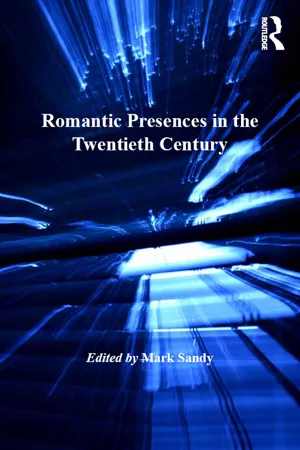
- 236 pages
- English
- ePUB (mobile friendly)
- Available on iOS & Android
Romantic Presences in the Twentieth Century
About This Book
Concerned with the intermingled thematic and formal preoccupations of Romantic thought and literary practice in works by twentieth-century British, Irish, and American artists, this collection examines the complicated legacy of Romanticism in twentieth-century novels, poetry, and film. Even as key twentieth-century cultural movements have tried to subvert or debunk Romantic narratives of redemptive nature, individualism, perfectibility, and the transcendence of art, the forms and modes of feeling associated with the Romantic period continue to exert a signal influence on the modern moment - both as a source of tension and as creative stimulus. As the essays here show, the exact meaning of the Romantic bequest may be bitterly contested, but it has been difficult to leave behind. The contributors take up a wide range of authors, including Virginia Woolf, F. Scott Fitzgerald, W. H. Auden, Doris Lessing, Seamus Heaney, Hart Crane, William Faulkner, Don DeLillo, and Jonathan Franzen. What emerges from this lively volume is a fuller picture of the persistence and variety of the Romantic period's influence on the twentieth-century.
Frequently asked questions
Information
Chapter 1 Leigh Hunt, Charles Lamb, and Virginia Woolf
Twilight comes; and the hour of the fireside, for the perfection of the moment, is now alone. He was reading a minute or two ago, and for some time was unconscious of the increasing dusk, till on looking up, he perceived the objects out of doors deepening into massy outline, while the sides of his fireplace began to reflect the light of the flames, and the shadow of himself and his chair fidgeted with huge obscurity on the wall. Still wishing to read, he pushed himself nearer and nearer to the window, and continued fixed on his book, till he happened to take another glance out of doors, and on returning to it, could make out nothing. He therefore lays it aside, and restoring his chair to the fireplace, seats himself right before it in a reclining posture, his feet apart upon the fender, his eyes bent down towards the grate, his arms on the chair's elbows, one hand hanging down, and the palm of the other turned up and presented to the fire, – not to keep it from him, for there is no glare or scorch about it, – but to intercept and have a more kindly feel of its genial warmth. … The evening is beginning to gather in. The window, which presents a large face of watery grey intersected by strong lines, is imperceptibly becoming darker; and as that becomes darker, the fire assumes a more glowing presence. The contemplatist keeps his easy posture, absorbed in his fancies; and every thing around him is still and serene. The stillness would even ferment in his ear, and whisper, as it were, of what the air contained; but a minute coil, just sufficient to hinder that busier silence, clicks in the baking coal, while every now and then the light ashes shed themselves below, or a stronger but still a gentle flame flutters up with a gleam over the chimney. At length, the darker objects in the room become mingled; the gleam of the fire streaks with a restless light the edges of the furniture, and reflects itself in the blackening window; while his feet take a gentle move on the fender, and then settle again, and his face comes out of the general darkness, earnest even in indolence, and pale in the very ruddiness of what it looks upon. – This is the only time perhaps at which sheer idleness is salutary and refreshing. How observed with the smallest effort is every trick and aspect of the fire! A coal falling in, – a fluttering fume, – a miniature mockery of a flash of lightning, – nothing escapes the eye and the imagination.6
Table of contents
- Cover Page
- Half-Title Page
- Series Page
- Title Page
- Copyright Page
- Table Of Contents
- Notes on Contributors
- Acknowledgements
- Introduction: The Persistence of Romantic Presences
- 1 Leigh Hunt, Charles Lamb, and Virginia Woolf
- 2 ‘Strong Ghosts’: Romantic Presences in Yeats’s Poetry
- 3 Flexible Genealogies and Romantic Poetics
- 4 ‘Altered Forms’: Romanticism and the Poetry of Hart Crane
- 5 The Measured Chaos of Gary Snyder’s Post-Romantic Poetic Form
- 6 Webs of Interlocution: Interaction with Others in Wordsworth and Auden
- 7 Seamus Heaney and Romanticism
- 8 Romantic Presences and the Latency of a Nascent Theory of Literature in Romantic Poetry
- 9 Romanticism’s Fragmentary Unities: Melville, Faulkner, and Lessing
- 10 ‘Fiery Particle’: Keats’s Romantic Presences in the Writings of F. Scott Fitzgerald
- 11 ‘Here then is a maze to begin, be in’: Michael Ondaatje’s Byronic Inheritance
- 12 The Ordinary: Wordsworth, Richard Ford and the Lie of Literature
- 13 ‘Putting the Mind Back into Nature’: The American Novel and the Science of Mind
- Selected Bibliography
- Index